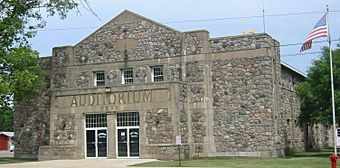Deerwood Auditorium facts for kids
Quick facts for kids |
|
|
Deerwood Auditorium
|
|

The Deerwood Auditorium from the south
|
|
| Location | 27 East Forest Road, Deerwood, Minnesota |
|---|---|
| Area | Less than one acre |
| Built | 1935–1937 |
| Architect | Carl H. Buetow, Works Progress Administration |
| Architectural style | Moderne |
| NRHP reference No. | 95001376 |
| Designated | November 29, 1995 |
The Deerwood Auditorium is a special community building in Deerwood, Minnesota. It was built a long time ago, between 1935 and 1937. This was during a tough time in history called the Great Depression. The building was part of a big government plan called the New Deal. This plan helped put people back to work and build important things.
In 1995, the Deerwood Auditorium was added to the National Register of Historic Places. This means it's a very important building because of its unique design, its connection to government programs, and its role in the community. It's a great example of a building that served many purposes and was built with help from the New Deal. It was also the largest project of its kind in Minnesota at the time.
Contents
What is the Auditorium Like?
The Deerwood Auditorium is a big, two-story building shaped like a rectangle. Its walls are made of strong concrete covered with split fieldstone. This gives it a cool, natural look. It also has special stone decorations in a style called Moderne. The roof is a medium-pitch gable roof, which means it slopes down on two sides.
This building has always been a busy place! It has been home to Deerwood's city council, which is like the local government. It also had the public library and space for fire trucks. Later, the police department used it too.
Inside, there's a large gym that can also be used as an auditorium. It has a stage at one end for performances or meetings. Upstairs, there are balconies on both sides of the auditorium. Downstairs, you'll find a kitchen and locker rooms. These different areas mean the building can be used for many things. People have held sports events, community meetings, plays, and big dinners there. It's also been used for talks, company gatherings, exhibits, and even graduation ceremonies.
How it All Started
Back in 1933, leaders in Deerwood wanted to build a community hall. But it was the Great Depression, and the town didn't have much money. A local person named Beriah Magoffin Jr. helped out. He bought a piece of land where an old oil station was. He then gave this land to the village for the auditorium. He also bought an old building from a mining company. The plan was to take it apart and use its materials for the new auditorium.
Even with the land and some materials, the town still needed money to actually build the hall. Luckily, President Franklin D. Roosevelt had started federal programs like the New Deal. These programs aimed to build lasting improvements and give people jobs. On October 9, 1934, the Deerwood Village Council met with Fred Pfeifer. He was the supervising architect for a program called the State Emergency Relief Administration (SERA). They talked about building the new community hall.
Carl H. Buetow designed the auditorium. He had worked with another famous architect in Minnesota, Clarence H. Johnston, Sr. To save money, they used many materials found right in the area. Local men gathered almost 800 tons of fieldstone for the building's outside walls! Some bricks were even saved from the old mining building.
Building the Auditorium
The Deerwood community hall project cost about $43,000. This money came from local funds and from the relief programs that provided jobs. In early March 1935, a team of 25 men started moving the heavy stones to the building site. Most of the stones came from the Cuyuna Country Club golf course. By early April, they began digging the basement and trenches for the building's foundation.
On August 2, 1935, construction had to stop. Only part of the walls were finished. The SERA work programs were canceled and moved to a new program called the Works Progress Administration (WPA). All projects had to be approved again by the WPA before work could continue. In late August, the state WPA administrator, Victor Christgau, announced that the Deerwood project was approved. So, work started up again!
However, in August 1936, work on the auditorium stopped again. They had run out of money. The workers were sent to other WPA projects. But five workers stayed to finish the auditorium's roof. By early September, the walls were complete. Everyone hoped the inside work would be done by November for the town's yearly lutefisk dinner.
Good news came in early October 1936: the WPA approved more money for the building. A full crew of workers returned to the site. When the lutefisk dinner was held in late October, about 1,000 people attended! The local newspaper, the Deerwood Enterprise, wrote that the new auditorium had its first big event. By February 1, 1937, the village council was already holding their meetings in the new building.
Why is it Important?
The Deerwood Auditorium is a great example of a modern community building. It was built thanks to the New Deal programs. It gave local people a place for performances, sports, government meetings, a library, and even a fire station. This building made life better for the people of Deerwood by offering many new services and activities.
In 2010, the outside of the auditorium was updated to keep its historic look. Even today, in the early 21st century, it is still the most important building in Deerwood.




